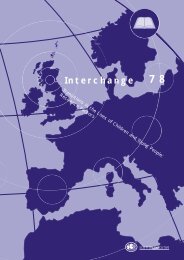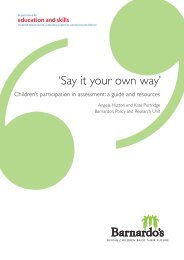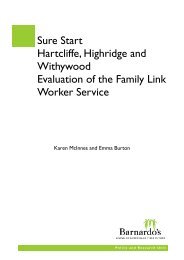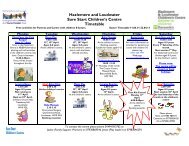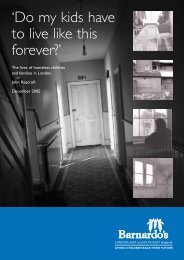Splintered Lives - Barnardo's
Splintered Lives - Barnardo's
Splintered Lives - Barnardo's
You also want an ePaper? Increase the reach of your titles
YUMPU automatically turns print PDFs into web optimized ePapers that Google loves.
oy ”doing everything", whilst at the same time saying that he was doing ”all the<br />
work"; he experiences guilt when he has to engage with the fact that this is in fact a<br />
child, and that he is not enjoying the encounter; that the strength of the effect of this<br />
engagement with reality lasts for all of three days. The responses of the boy suggest<br />
fear and distress, yet the man proceeds anyway. His account is an attempt to justify<br />
actions which cannot be described in terms other than abusive.<br />
Towards a model: the impacts of sexual exploitation<br />
Within the clinical literature on traumatic stress are many models of the common<br />
responses to both general and particular forms of trauma: battered women's syndrome,<br />
rape trauma syndrome and post traumatic stress disorder are examples of these<br />
models. All these models, however, presume discrete events bounded in time and space<br />
which constitute the trauma. None cover the successive compounding events which are<br />
likely to be present for many children and young people involved in sexual exploitation.<br />
That said, however, it is possible to draw from these models the basic conceptual<br />
framework underpinning them (see Briere, 1992; Herman, 1994). A core response to<br />
traumatic events at the time and over time is Il disassociation". John Briere defines it as<br />
“a defensive disruption in the normally occurring connections among feelings,<br />
thoughts, behaviour and memories consciously or unconsciously invoked to reduce<br />
psychological distress”. Disconnecting - disassociating - elements of memory and<br />
emotion protects the individual from the potentially devastating consequences of selfknowledge.<br />
Disassociation is a defensive and self-protective coping strategy which'<br />
permits an escape from the pain of reality.<br />
It is generally a subconscious rather than intentional choice, in the face of<br />
overwhelming anxiety, pain and distress. By forgetting an experience totally, or<br />
compartmentalising aspects of experience, physical and psychological survival<br />
becomes possible. Some common examples of disassociation which survivors of abuse<br />
report are: 'cutting off' from an assault, and a sense of watching from outside one's<br />
body; living in the times when the abuse/violence is not occurring and/or a sense of<br />
living in two disconnected realities; constructing a fantasy world in which one is happy<br />
and safe; a numbing of emotional responses. Whilst disassociation has been most<br />
thoroughly documented in relation to sexual abuse in childhood, these coping<br />
strategies are also frequently discussed by women who have been raped, who have<br />
experienced domestic violence and who have been involved in pornography and<br />
prostitution.<br />
Disassociation also explains why many women and children do not tell about abuse for<br />
long periods, why it is hard for them to talk about the details of what happened, and<br />
why they can sometimes talk about what happened in a flat and unemotional tone.<br />
Disassociation takes a range of forms. It can be total, where all memory of events is<br />
locked away from conscious knowledge, or partial, where aspects of memory remain<br />
but are separated from the emotional responses and meanings which belong with them.<br />
PAGE 51<br />
chapter<br />
8






